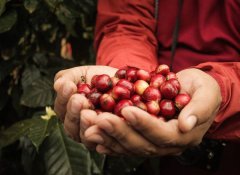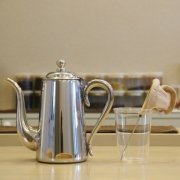World Coffee experience traditional Greek Coffee
I recently went on vacation to RODOS, which is closest to Turkey in Greece, which is a small island with a strong European flavor. In addition to the ancient medieval castles, Knights Street and the charming Butterfly Valley, I was attracted by a traditional coffee.
I stayed in a three-star hotel called AGLA HOTEL, which was small but full of breakfast. The waiter offered a pot of coffee or English black tea with a warm attitude, but there was such a table on the side of the restaurant.

The wall next to it is written in Greek and English:

At first, I didn't know how to operate it, and I was very curious, so I chose a nearby seat for breakfast, but finally an older guest started to make it, and I watched carefully.
This is a coffee heating stove. The red light turns on and off, indicating that the furnace is being heated.

There is an inch of fine sand in the furnace, which is always kept at a certain temperature.

Put the coffee powder in the bottle on the table with two tablespoons into the copper pot, then pour the water next to it into the copper pot, half the amount, then boil the copper pot in the hot sand, often carrying the copper pot to move in the sand, so that the different sides of the copper pot can be warmed, in about 5-7 minutes, the pot begins to foam, but will not spill, so that the coffee is ready.

Pour the coffee from the copper pot into the coffee cup. the stainless steel container on the table is white granulated sugar, sugar and milk. A cup of do-it-yourself traditional Greek coffee is done!

The next day, when I saw that I was in production, a few elderly Westerners were curious and asked me what to do. How do you like it? When I told them, I found that they were also very interested in experiencing it. I thought only those of us who were not familiar with the history and culture of coffee had never seen coffee making in this way, but they told me that they had never seen coffee made in this way. I think there must have been several people sitting together in ancient times, each with a small copper pot and several copper pots burning together in the sand, burning and chatting at the same time. This is the traditional Greek coffee culture. Maybe there are a large number of world-famous philosophers, thinkers and scientists in ancient Greece, which has something to do with this coffee-making process? Haha, it's too far. When there were philosophers in ancient Greece, coffee hadn't been discovered yet.
Important Notice :
前街咖啡 FrontStreet Coffee has moved to new addredd:
FrontStreet Coffee Address: 315,Donghua East Road,GuangZhou
Tel:020 38364473
- Prev

The Source of Ice drop Coffee
The origin of ice drop coffee ice drop coffee originated in Europe, because the coffee distiller was invented by the Dutch, some people call it Dutch Coffee, espresso or water drop coffee. Ice drop coffee is extracted bit by bit for about 8 hours due to its compatibility with water, mainly by condensation and natural osmotic water pressure. The smell of coffee extracted by a coffee distiller
- Next

The method of making coffee by hand-brewing Drip drip filter cup
Prepare 600-700 ml of water, then heat the ing. Weigh 25-30g coffee beans. At this time, use a bean grinder to grind the coffee beans into powder while the water is still heating. The coffee powder is about the same thickness as unprocessed sea salt. Put the tapered filter paper into the filter cup and connect the glass at the bottom. First soak the filter paper with some hot water and heat the filter cup (the filter cup in the picture is ceramic).
Related
- Beginners will see the "Coffee pull flower" guide!
- What is the difference between ice blog purified milk and ordinary milk coffee?
- Why is the Philippines the largest producer of crops in Liberia?
- For coffee extraction, should the fine powder be retained?
- How does extracted espresso fill pressed powder? How much strength does it take to press the powder?
- How to make jasmine cold extract coffee? Is the jasmine + latte good?
- Will this little toy really make the coffee taste better? How does Lily Drip affect coffee extraction?
- Will the action of slapping the filter cup also affect coffee extraction?
- What's the difference between powder-to-water ratio and powder-to-liquid ratio?
- What is the Ethiopian local species? What does it have to do with Heirloom native species?

